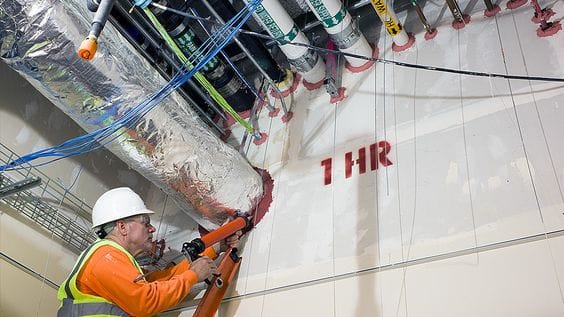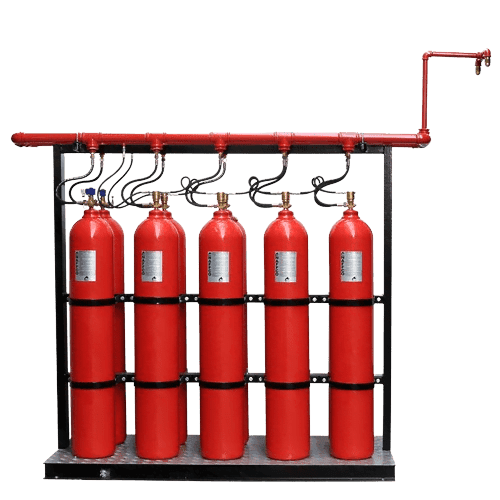Passive fireproofing and active fireproofing are two fundamental options to protect buildings and structures against the significant effects which may be induced on both occupants and property through these means. It is the use of construction techniques and fire-resistant materials in order to limit fire spreading and to minimize possible damage, such as fire retardant materials, structural elements created for high temperatures, and fire-resistant coatings are used in these applications.
Systems and equipment that actively detect, control, or suppress fires, for example, are supported by active fireproofing, and this method is necessary after the fire event has started. Prevention is the primary purpose of passive fireproofing. However, suppression or control after the fire has started depends on intervention by these active systems. These two methods have a central importance, because active fireproofing is designed for intervention when a fire occurs and passive for controlling the fire. The safety of an architectural structure can be balanced by the usage of both passive and active fireproofing methods. It should be noted, the selection of either method does not exclude the other—both are important and should be considered together for effective fire safety.
The Role of Passive Fireproofing in Building Safety
Definition: Passive fire protection refers to the design and construction features that are built into the structure of a building to prevent or slow the spread of fire, smoke, and heat.
Passive fireproofing has been adopted in the field of building safety to act as an initial strategy which consists of both inclusion of fire-resistant materials and specialized construction methods into the architectural design, which can significantly hinder flames and heat from moving quickly throughout a structure while also slowing the rate at which fire can compromise critical components; this consideration is important.
The process can be observed when fire-resistant materials collapse during a fire event. Occupants are safer when passive methods are used. Not only does passive fireproofing restrict fire to localized zones, but fire is also limited by these containment strategies, which simplify suppression efforts. Less property gets destroyed. The risk for those inside can be reduced by using passive fireproofing measures that isolate flames in intentional sections.
Passive fireproofing is often found in facilities that are industrial, large commercial buildings, and instances where buildings are more than several floors. Rapid fire suppression makes this strategy very practical. Also, containment has been designed to make things manageable if fire starts. When the method is included at the design stage, results are better.
Key Characteristics:
- Non-Actionable: PFP systems do not require any action or power to work; they are inherently built into the building’s design and materials to contain a fire or limit its spread.
- Integrated into Building Design: These systems focus on containment, insulation, and the use of materials that prevent fire from spreading or compromising the structural integrity of the building.
Examples of Passive Protection:

- Fire-Resistant Materials: Concrete and steel are key, especially when coated with heat-resistant materials to slow the spread and buy more time for escape and intervention.
- Fire Walls and Compartmentalization: Dividing the building into sections helps contain the spread, isolating the incident to one area and preventing widespread damage.
- Fire-Resistant Doors and Windows: These elements help contain heat and limit damage for a specified time, providing crucial minutes to control the situation.
- Fire-Stopping: Seals around pipes, ducts, and cables keep gaps closed, stopping heat from traveling through the building unchecked. (Fig 1)
- Structural Fire Protection: Coatings and insulation on structural elements like steel beams ensure they retain strength and integrity when exposed to extreme temperatures, preventing collapse.
Advantages:
- Provides ongoing, 24/7 protection without the need for power or human action.
- Reduces the overall spread of fire and helps limit property damage.
- Can be more cost-effective over the long term because once installed, it requires little maintenance.
Disadvantages:
These materials slow the spread of flames but don’t extinguish them. Some passive measures, like fire-resistant coatings, may degrade over time or with damage. They can’t fully prevent escalation without active measures in place.
When combined with active systems, they provide comprehensive protection, helping save lives and reduce damage. Both systems must be properly maintained for effective response in emergencies.
The Role of Active Fireproofing in Building Safety
Definition: Active fire protection refers to systems and technologies that require some type of action (either automatic or manual) to combat or control a fire when it occurs.
Active fireproofing comprises an assortment of fire protection systems, designed to prevent gas emission and smoke within buildings and to respond quickly and in real time to dangerous events; it is distinguished from passive fireproofing by its dynamic approach to emergency situations, rather than the simple resistance offered by special mechanisms included in these systems. It’s during fire events that these mechanisms are triggered and action is taken.
Active fireproofing’s function in supporting building maintenance means property damage is significantly reduced, and the structural reliability during crisis is maintained when such measures are present. Installing these measures in buildings significantly increases fire safety demands. High standards can only be maintained if both active and passive methods are combined for complete fire protection.
Key Characteristics:
- Action-Dependent: AFP systems are designed to actively respond to a fire by suppressing it, alerting occupants, or isolating it to prevent further spread.
- Requires Power or Manual Operation: Most AFP systems require a power source or human intervention to function effectively. This includes electrical power, water supply, or even manual operation of devices.
Examples of Active Protection:

- Sprinkler Systems – Automatically activate when heat hits a certain level, discharging water or other agents to suppress the blaze.
- Extinguishers – Hand-held devices for manually tackling small blazes.
- Alarms and Smoke Detectors – Systems that detect smoke or heat, alerting occupants or fire services.
- Suppression Systems – Specialized systems (foam or gas) used where water isn’t effective, like in electrical rooms, data centers, or kitchens. (Fig 2)
- Automatic Closing Fire Doors – Doors that close on their own, helping limit the spread between compartments.
Advantages:
- Can quickly suppress or control a fire, potentially reducing damage.
- Can be automatic, requiring minimal human intervention once activated.
- Provides real-time response to a fire emergency.
Disadvantages:
- Depend on a power source or maintenance to remain functional.
- Can be expensive to install and maintain, particularly advanced suppression systems.
- May require periodic testing and inspection to ensure reliability.
Comparing Passive and Active Fireproofing Techniques
| Technique | Application Time | Effectiveness |
| Passive Fireproofing | Long | Effective for structural protection |
| Active Fireproofing | Short | Effective for localized protection |
Key Differences:
| Feature | Passive Fire Protection (PFP) | Active Fire Protection (AFP) |
|---|---|---|
| Activation Required? | No | Yes |
| Purpose | Containment, delaying spread | Detection, suppression, extinguishing |
| Examples | Resistant coatings, rated walls, dampers | Sprinklers, alarms, extinguishers |
| Maintenance Needs | Minimal (inspections for integrity) | Regular maintenance and testing |
Integrating Passive and Active Fireproofing for Maximum Protection
Protection against fire hazards can be maximized through the integration of both passive and active fireproofing methods, and these can be combined due to the complementary nature of these techniques, which enable a stronger defense. Passive fireproofing, for example, can provide greater fire safety. Once passive systems are installed, the early detection of a blaze and the prompt initiation of suppression measures are enabled with greater speed. The strengths of these methods are complemented by each other, working very well together. By combining alarms and sprinklers with material that resists fire, one develops a strategy that focuses on both preventing and responding to fire events, adding an extra layer of protection that cannot be achieved with just one method; a robust defense is formed. Each method supports the other, and resilience is improved throughout the structure as a resul
Why Use Both?
A strong safety plan combines passive and active methods for maximum protection. While passive systems limit damage and prevent rapid spread, active measures work to stop hazards before they escalate.
Disadvantages:
- Depend on a power source or maintenance to remain functional.
- Can be expensive to install and maintain, particularly advanced suppression systems.
- May require periodic testing and inspection to ensure reliability.
Choosing the Right Fireproofing Approach: Passive Versus Active Considerations
When a fireproofing method is being selected for a building or similar structure, the particular context of the place should be considered carefully, as these factors influence the appropriate strategies for fire safety; the context matters greatly. The likelihood of frequent fires is relatively low, or in cases where long-term dependability is needed, other structures are exposed to greater risks. A mix of passive and active fireproofing methods can be more beneficial for locations situated in high-risk areas, or when occupancy patterns are complex and variable; thus, the strengths of multiple mechanisms are used together.
Active fireproofing systems can respond directly to specific threats and passive systems may require less maintenance over time; however, due attention should also be paid to occupancy type, so that project designers perform a thorough evaluation of each building’s individual characteristics. A strategy for fire safety is formed after that. Through this careful assessment, the strengths of both passive and active systems will be best utilized.
